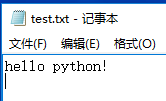sys.argv[]是用来获取命令行参数的,sys.argv[0]表示代码本身文件路径,所以参数从1开始,以下两个例子说明:
1、使用sys.argv[]的一简单实例:
以下是sample1.py文件:
-
import sys,os
-
print sys.argv
-
os.system(sys.argv[1])
这个例子os.system接收命令行参数,运行参数指令,cmd命令行带参数运行python sample1.py notepad,将打开记事本程序。
2、这个例子是简明python教程上的,明白它之后你就明白sys.argv[]了。
以下是sample.py文件:
-
#!/usr/bin/env python
-
#_*_ coding:utf-8 _*_
-
import sys
-
def readfile(filename): #定义readfile函数,从文件中读出文件内容
-
'''''''Print a file to the standard output.'''
-
f = file(filename)
-
while True:
-
line = f.readline()
-
if len(line) == 0:
-
break
-
print line, # notice comma 分别输出每行内容
-
f.close()
-
# Script starts from here
-
print sys.argv
-
if len(sys.argv) < 2:
-
print 'No action specified.'
-
sys.exit()
-
if sys.argv[1].startswith('--'):
-
option = sys.argv[1][2:]
-
# fetch sys.argv[1] but without the first two characters
-
if option == 'version': #当命令行参数为-- version,显示版本号
-
print 'Version 1.2'
-
elif option == 'help': #当命令行参数为--help时,显示相关帮助内容
-
print '''
-
This program prints files to the standard output.
-
Any number of files can be specified.
-
Options include:
-
--version : Prints the version number
-
--help : Display this help'''
-
else:
-
print 'Unknown option.'
-
sys.exit()
-
else:
-
for filename in sys.argv[1:]: #当参数为文件名时,传入readfile,读出其内容
-
readfile(filename)
在与sample.py同一目录下,新建3个记事本文件test.txt,test1.txt,test2.txt,内容如下图:


验证sample.py,如下:
C:Users91135Desktop>python sample.py
['sample.py']
No action specified.
C:Users91135Desktop>python sample.py --help
['sample.py', '--help']
This program prints files to the standard output.
Any number of files can be specified.
Options include:
--version : Prints the version number
--help : Display this help
C:Users91135Desktop>python sample.py --version
['sample.py', '--version']
Version 1.2
C:Users91135Desktop>python sample.py --ok
['sample.py', '--ok']
Unknown option.
C:Users91135Desktop>python sample.py test.txt
['sample.py', 'test.txt']
hello python!
C:Users91135Desktop>python sample.py test.txt test1.txt test2.txt
['sample.py', 'test.txt', 'test1.txt', 'test2.txt']
hello python!
hello world!
hello wahaha!
goodbye!
C:Users91135Desktop>
